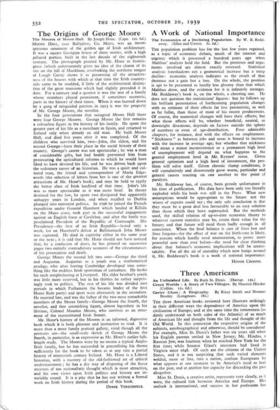The Origins of George Moore
The Moores of Moore Hall. By Joseph Hone. (Cape. tzs. 6d.) MOORE HALL, near Ballyglass, Co. Mayo, was an incon- spicuous ornament of the golden age of Irish architecture. It was a square Georgian house of three stories, with a high pillared portico, built in the last decade of the eighteenth century. The photograph printed by Mr. Hone as frontis- piece (which unfortunately gives no idea of the charm of its site on the hill of Mucidoon, overlooking the northern tongue of Lough Carra) shows it as possessing all the attractive- ness of the houses with which at that time the Irish country- side came to be studded, if little of the architectural distinc- tion of the great mansions which had slightly preceded it in date. For a century and a quarter it was the seat of a family whose members played prominent, if sometimes eccentric, parts in the history of their times. When it was burned down by a gang of misguided patriots in 1923 it was the property of Mr. George Moore, the novelist.
In the four generations that occupied Moore Hall there were four George Moores. George Moore the first remains a colourless figure in the history of his family. He spent the greater part of his life as a merchant in Spain, and returned to Ireland only when already an old man. He built Moore Hall, and died five years after it was completed. Of the children who survived him, two—John, the eldest, and the second George—have their place in the social history of their country. George's career was not spectacular ; he was a man of considerable gifts, but bad health prevented him from prosecuting the agricultural reforms to which he would have liked to have devoted his life, and he was driven back upon the sedentary career of an historian. He was a quiet and cul- tured man, the friend and correspondent of Maria Edge- worth (the selection of letters from her is one of the greatest attractions of Mr. Hone's book), and may be held to typify the better class of Irish landlord of that time. John's life was as more spectacular as it was more brief. In theory destined for the law, he spent two dissipated but apparently unhappy years in London, and when recalled to Dublin plunged into extremist politics. In 1798 he joined the French expedition under General Humbert which landed at Killala on the Mayo coast, took part in the successful engagement against an English force at Castlebar, and after the battle was proclaimed President of the Republic of Connaught. His Presidency—the first of an Irish Republic—lasted only a week, for on Humbert's defeat at Ballinamuck John Moore was captured. He died in captivity either in the same year or the next ; it is odd that Mr. Hone should not have noticed that, by a confusion of dates, he has printed on successive pages two entirely contradictory accounts of the circumstances of his prosecution and death.
George Moore the second left two sons—George the third and Augustus. Augustus as a youth was a mathematical prodigy, who after leaving Cambridge developed into some- thing like the reckless Irish sportsman of caricature. He broke his neck steeplechasing at Liverpool. His elder brother's youth was little more reserved, but in his thirties he rather surpris- ingly took to politics. The rest of his life was divided into periods in which Parliament (he became leader of the first Home Rule party) and sport were alternately in the ascendant. He married late, and was the father of the two most remarkable members of the Moore family—George Moore the fourth, the novelist, and that astonishing figure, almost legendary in his Lifetime, Colonel Maurice Moore, who survives as an orna- ment of the reconstituted Irish Senate.
Mr. Hone's history of the Moores is an informal, digressive book which it is both pleasant and instructive to read. It is more than a mere family portrait gallery, vivid though all the portraits are—the small-scale sketch of George Moore the fourth, in particular, is as expressive as Mr. Hone's earlier full- length study. The Moores were by no means a typical Anglo- Irish family, but he has succeeded in generalising his theme sufficiently for the book to be taken as at any rate a partial history of nineteenth century Ireland. Mr. Hone is a Liberal historian, with a mastery of the old-fashioned art of critical understatement ; he has a dry way of disposing of the fierce excesses of too nationalistic thought which is most attractive, and his own views upon Irish politics and history are in- variably sound. It is a pity that he has not written a formal work on Irish history during the period of this book.
DEREK VERSCHOYLE.












































 Previous page
Previous page